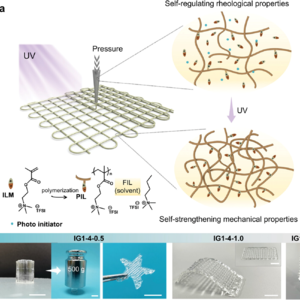3D Printing of Ionogels with Complementary Functionalities Enabled by Self-Regulating Ink
Citation
Jiahui Huang, Zhenchuan Yu, and Peiyi Wu*. 3D Printing of Ionogels with Complementary Functionalities Enabled by Self-Regulating Ink. Adv. Sci. 2023,10, 2302891.
Abatract
Shaping soft and conductive materials into sophisticated architectures through 3D printing is driving innovation in myriad applications, such as robotic counterparts that emulate the synergic functions of biological systems. Although recently developed multi-material 3D printing has enabled on-demand creation of intricate artificial counterparts from a wide range of functional viscoelastic materials. However, directly achieving complementary functionalities in one ink design remains largely unexplored, given the issues of printability and synergy among ink components. In this study, an easily accessible and self-regulating tricomponent ionogel-based ink design to address these challenges is reported. The resultant 3D printed objects, based on the same component but with varying ratios of ink formulations, exhibit distinct yet complementary properties. For example, their Young’s modulus can differ by three orders of magnitude, and some structures are rigid while others are ductile and viscous. A theoretical model is also employed for predicting and controlling the printing resolution. By integrating complementary functionalities, one further demonstrates a representative bioinspired prototype of spiderweb, which mimics the sophisticated structure and multiple functions of a natural spiderweb, even working and camouflaging underwater. This ink design strategy greatly extends the material choice and can provide valuable guidance in constructing diverse artificial systems by 3D printing.


